
by ffadmin | May 27, 2014 | Tips & Tricks
Fruit smoothies are a healthier breakfast than sugary cereal— but they could be falling short of their nutritional potential if you’re inadvertently making these mistakes.
You forgo the fiber.
Fiber—soluble and insoluble— is one of the most underrated, overlooked elements of weight loss and a healthy diet. It sweeps through your system, grabbing fat or lodged waste, and escorts it out of your body. You might be imagining Grandpa, stirring chunks of grass into some water and cringe, but fiber is part of the make up of your favorite foods! Fresh fruit is highly fibrous—think strawberries, citrus, and apples. But fiber-rich foods you may be leaving out of your smoothies are greens like kale and spinach, or chia seeds which is considered one of the world’s most fibrous foods.
Your protein powder is a scoop of sabotage.
Go to your cabinet and check the label on your protein powder. Whether you prefer whey protein or plant protein powder, the ingredients list shouldn’t be as long as your arm. Another thing to watch out for is impurities within the list— junk that doesn’t belong in your protein powder are things like soy, sugar (in all its forms; sucrose, dextrose, maltose), artificial sweetener (in all its forms; aspartame, saccharin, sucralose), and heavy metals. If your protein powder contains tons of ingredients and filler ingredients, chances are it’s burdening your body more than it’s helping.
You’re overloading on fruit.
Fruit is healthy, yes, but it is possible to overdo it. Keep in mind that, although it occurs naturally, fruit is still a source of sugar—fructose, to be precise. When it comes to smoothies, use fruits that are high in health benefits and low in sugar (like berries, cherries and peaches) to help keep the sugar content low without sacrificing the fruity flavor.
You sprinkle some extra sweeteners.
If you’re making a fruit smoothie, adding sweetener—even honey or maple syrup—is pretty unnecessary. (Remember the natural sugar content of fruit we just talked about?) If your sweet tooth has a stronghold, start off by making smoothies with fruits that are especially sweet, like blueberries. The good news is our taste buds change; they will grow accustomed to not “need” copious amounts of flavor enhancers—this is also good news if you are struggling with over-salting your food.
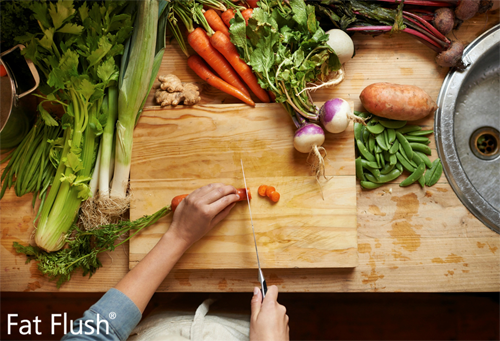
by ffadmin | May 19, 2014 | Tips & Tricks
Cooking at home is the best way to clean up your diet because you know exactly what you’re eating and can carefully consider each ingredient. However, the complete freedom can also be temptation to cheat just a tad— adding an extra dash of this, or pinch of that, is so easy to get carried away with.
Here are some common habits that happen in the kitchen that may be sabotaging your weight loss efforts.
Overusing the oil.
While some oils do have nutritional value, using too much moves beyond beneficial and moves into a high calorie load. We like using olive oil spray when recipes call for oil as a non-stick agent because the spray only dispenses a small amount of oil. Another kitchen trick that works perfectly is using a bit of broth instead of oil! It prevents food from sticking while adding flavor and avoiding extra calories.
One convenient strategy for easy meals that are ready-to-go is to make a double batch, freezing half for later. In a restaurant, you might put half your meal in a to-go box before you even start eating so you’re sure not to overeat. It’s a good idea to do this at home, too! When you make a big batch, put half away before you start serving yourself. This will help you have a more realistic view of how much food is on your plate.
Sticking with the same seasonings.
There are so many herbs and spices available, and they’re packed with nutritional benefits! Don’t get stuck in the “salt and pepper” rut—try some new seasonings methods! Cutting back on salt will also let the natural flavors of the food shine through, without alteration. If you’re used to cooking with lots of salt, start slow— lessening the increment of salt a little at a time, until your taste-buds don’t need salt anymore. (It does happen!) Just as your buds got used to the salty flavor, they will change to not need it anymore. Use the other spices available to help you get away from the salt shaker.
Following the recipe blindly.
The fun thing about cooking is you can make things according to your own taste, literally. Tailoring a recipe to your taste-buds—and health requirements— is important when you’re trying to live a healthy lifestyle. Substitute some not-so-healthy ingredients for a Fat Flush-friendly ingredient, like Mashed Cauliflower instead of mashed potatoes. (Here are a few more healthy substitution ideas!)
Munching too much.
Tasting as you cook is important to adjust seasonings in your dish, but keep in mind that these little nibbles count as intake and will add up. Try having a small snack before you start cooking so you aren’t ravenously hungry, which leads to too much nibbling and ‘testing’. Think sliced veggies or a few almonds.
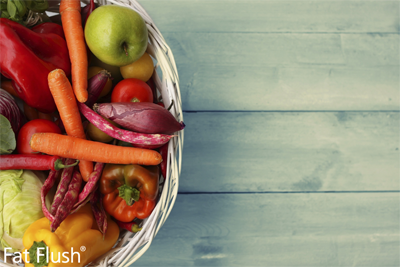
by ffadmin | May 12, 2014 | Tips & Tricks
Everyone knows that fresh fruits and veggies are an imperative part of a well-rounded diet for weight loss and exceptional overall health. In fact, a study published in the Journal of Epidemiology & Community Health reveals that people who ate at least 7 helpings of produce a day increased cardiovascular health and reduced risk of cancer.
So, how can you pack all those fresh foods into your day? Try a few of these ideas!
Blended
Let’s start slow— smoothies are the obvious go-to for incorporating fruits and veggies into your daily diet. They’re easy to make and easy to take, plus the yummy combinations are endless. When you think of making a smoothie, you probably automatically think of fruits like berries and melon. But don’t discount veggies! Smoothies are an excellent way to get a healthy helping of vegetables like spinach, kale, cucumber, carrots, squash…and more!
Hidden
Adding fruits and veggies to foods you already eat is a simple way to get an extra helping or two. Add a handful of fresh berries to your morning yogurt, some sliced veggies to the wrap you’re having for lunch, or saute them with meat for the Lettuce Wraps you’re making for dinner. Scrambled eggs are also a great way to incorporate some vegetables to your morning routine!
Juiced
Smoothies are one way to drink your vitamins, and juice is another. Whether you make your own juice or buy juice from the grocery store, this is a refreshing—easy— way to get those vitamins. Just be sure to read labels carefully when shopping for juice at the store. It is quite common for juices to have added sugar, fillers, and artificial ingredients. Fat Flush Water calls for 100% unsweetened cranberry juice, and it is important to read the ingredients to make sure that’s what you’re getting.
Swapped
Instead of eating a plate full of pasta, use zucchini ribbon or spaghetti squash instead. Pair those with your favorite sauce and lean protein, and you won’t even miss the pasta! If you’re craving a crunchy treat, bake some Kale Chips instead of reaching for calorie-laden potato chips. Need to satisfy a sweet tooth? Substitute a handful of sweet berries for a piece of sugar-packed candy. This technique might take a bit more planning and creativity than the other methods, but once you get the idea, it will become second nature. (Get more ideas for Healthy Recipe Substitutions here.)
Mixed
This is the perfect idea for when you just need a bit of excitement, something varied and interesting— because sliced cucumber is yummy, but sometimes you just need something different. Mix and match your vegetables in 1 bowl, tossed with a touch of apple cider vinegar and flaxseed oil for a light dressing. (You could even toss some herbs in the bowl, if you have some on-hand.) Tomatoes, peppers, carrots, zucchini, olives…the list goes on and they’re all delicious when you put them together. You could do the same with fruit— although we suggest leaving out the vinegar and flaxseed oil dressing. Mixed berries, apples, orange slices, cherries— whatever fruit you have in the fridge can make a beautifully fresh fruit salad.
What are some of the ways you get a good helping of fresh fruits and vegetables in your day?
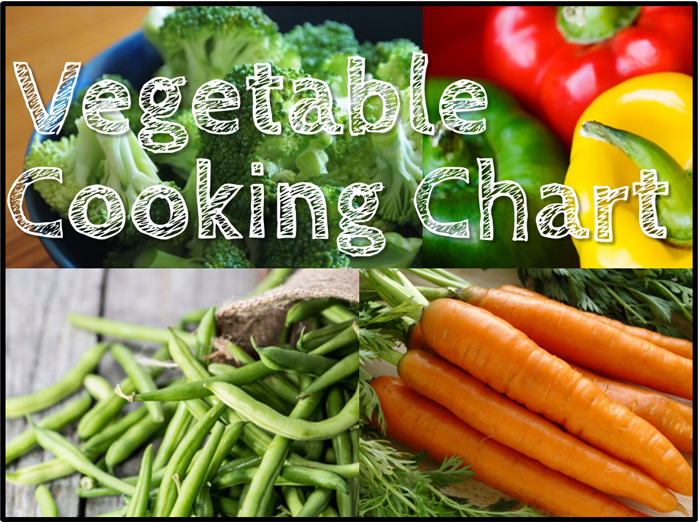
by ffadmin | May 2, 2014 | Tips & Tricks
Use this chart as a guide in the kitchen for perfectly cooked vegetables, every time!

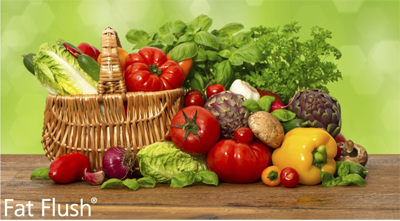
by ffadmin | Apr 8, 2014 | Tips & Tricks
Spring is in the air and now is the perfect time to start exploring the light flavors of a warmer season!
Nature is blooming with renewed energy and this is the best time of the year to turn attention to nutrient-rich produce for complete liver detoxing power. It’s time to leave behind the heavy foods of winter and start exploring the fresh, lighter flavors of Spring!
Artichokes
With powerful antioxidants and phytonutrients such as cynarin and silymarin, artichokes are a super-food for your liver. They are also high in potassium, which improves heart health, and fiber for healthy digestion.
Try it in our Baked Chicken and Artichoke Casserole.
Asparagus
These amazing stalks are high in potassium and low in sodium, helping to fight water retention by flushing out excess fluids. Asparagus also contains high amounts of inulin, a prebiotic that helps feed the good bacteria in your digestive system.
Try our easy Roasted Asparagus recipe.
Broccoli
This cruciferous vegetable offers a full bounty of iron, vitamins A and C, potassium, and fiber. The chromium in broccoli has been known to maintain stable blood sugar levels.
Try our Citrus Broccoli recipe.
lard Greens
A cousin to kale and cabbage, these greens are wonderfully nutritious. Containing both soluble and insoluble fiber, collards are ideal for keeping cholesterol in check and digestion moving smoothly. These leafy greens also contain healthy amounts of iron, calcium, and vitamins A, C, and K.
Try our recipe for Spicy African Collard Greens.
Cucumbers
Crunchy and fibrous, this veggie also offers plenty of vitamin C, potassium, and magnesium. Cucumbers also contain a healthy dose of silica which is essential to healthy connective tissue; it helps build strong bones, muscles, and tendons.
Try our recipe for Cucumber Kinda-Caprese Salad or Cucumber Mint Smoothie.
Endive
Native to the Asian region, endive is another leafy vegetable that offers lots of fiber which helps reduce cholesterol levels. It is also rich in beta-carotene and vitamin A which aids in healthy skin, good eye sight, and strong lung health.
Enjoy fresh endive leaves paired with our Homemade Salsa instead of chips.
Jicama
A powerful root, jicama is a solid source of fiber— 1 cup of jicama provides almost 6 grams of fiber. Bursting with vitamin C, it can help keep LDL (‘bad’) cholesterol from oxidizing and can also help protect against heart disease.
Try our recipe for Jicama Salad.
Kale
These leafy greens provide more nutritional value for fewer calories any other food. Kale is one of the best vegetable sources of vitamin A, plus calcium, manganese, and vitamin C.
Try our recipe for Kale Chips or this Green Apple & Kale Smoothie.
Spinach
Packed with antioxidants like vitamins C and E, beta-carotene, and zinc, spinach helps battle damaging free radicals. The high vitamin A content fortifies mucous membranes, respiratory system and is a key component for healthy white blood cells, all of which help fight infections and strengthen immunity.
Try our Lime Booster Smoothie.
Onions
Though they may bring tears, raw onions help with production of HDL (‘good’) cholesterol in the body. Onions also contain chromium which can stabilize blood sugar and quercetin, a powerful antioxidant.
Enjoy onions in our simple Shrimp Ratatouille recipe.
Watercress
A cousin of cruciferous veggies like broccoli and Brussels sprouts, watercress is known to offer over 15 essential vitamins and nutrients. Though it covers an array of nutrients, these leafy greens tout an extremely high vitamin K content which is crucial for good bone and brain health.
Try our recipe for Fat Flush-Friendly Chicken Salad.
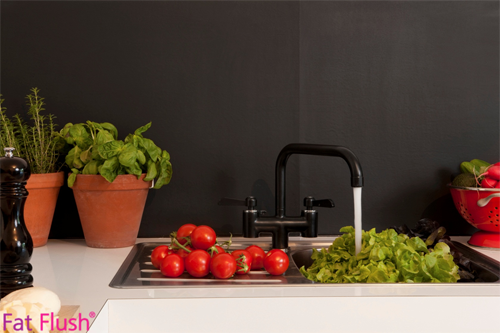
by ffadmin | Mar 14, 2014 | Tips & Tricks
Food Network Magazine released their 100 Greatest Cooking Tips (of all time!) list with tips from top chefs across the country. Here is an excerpt from that list, for Fat Flush-friendly kitchens everywhere!
1. Remember, y’all, it’s all about the prep. Take away the stress by doing the prep the night or day before. You’ll look like a star.
Paula Deen
2. Store spices in a cool, dark place, not above your stove. Humidity, light and heat will cause herbs and spices to lose their flavor.
Rick Tramonto
3. Always make stock in a large quantity and freeze it in plastic bags. That way, when you want to make a nice soup or boil veggies, you can simply pull the bag out of the freezer.
Charlie Trotter
4. After working with garlic, rub your hands vigorously on your stainless steel sink for 30 seconds before washing them. It will remove the odor.
Gerard Craft
5. For rich, creamy dressings made healthy, substitute half the mayo with Greek-style yogurt.
Ellie Krieger
6. When chopping herbs, toss a little salt onto the cutting board; it will keep the herbs from flying around.
Joanne Chang
7. If you keep it simple and buy ingredients at farmers’ markets, the food can pretty much take care of itself. Do as little as possible to the food; consider leaving out an ingredient and relying on instinct.
Tony Mantuano
8. Homemade vinaigrettes have fewer ingredients and taste better than bottled ones. No need to whisk them: Just put all the ingredients in a sealed container and shake.
Bill Telepan
9. When making meatballs or meatloaf, you need to know how the mixture tastes before you cook it. Make a little patty and fry it in a pan like a mini hamburger. Then you can taste it and adjust the seasoning.
Isaac Becker
10. Instead of placing a chicken on a roasting rack, cut thick slices of onion, put them in an oiled pan, then place the chicken on top. The onion will absorb the chicken juices. After roasting, let the chicken rest while you make a sauce with the onions by adding a little stock or water to the pan and cooking it for about 3 minutes on high heat.
Donald Link
11. Take the time to actually read recipes through before you begin.
John Besh
12. Recipes are only a guideline, not the Bible. Feel comfortable replacing ingredients with similar ingredients that you like. If you like oregano but not thyme, use oregano.
Alex Seidel
13. Taste as you go!
Anne Burrell
14. For safety, put a wine cork on the tip of a knife before putting the knife in a drawer.
Giuseppe Tentori
15. When you’re going to sauté garlic, slice it rather than mincing it — it’s less likely to burn that way.
Aarti Sequeira
16. Smash garlic cloves inside a resealable plastic bag with the back of a knife. That way, your cutting board and knife won’t smell.
Laurent Tourondel
17. To get nice, crispy caramelization on roasted vegetables, simulate the intense heat of an industrial oven: Bring your oven up as hot as it goes, then put an empty roasting or sheet pan inside for 10 to 15 minutes. Toss the vegetables — try carrots or Brussels sprouts — with olive oil, salt and pepper, and put them on the hot pan. This method will give you the high heat you need to caramelize the sugars in the vegetables quickly.
Naomi Pomeroy
18. Marinating meat with citrus can give it a mealy texture. If you like citrus, a little squeeze of lemon or lime is always a good way to finish the dish instead.
Tim Love
19. Always use sharp knives. Not only is it safer but it will make your work much more efficient.
April Bloomfield
20. Rest, rest, rest! Always let your meat rest — especially off a hot grill!
Melissa d’Arabian
21. Plunge vegetables in ice water after blanching (boiling) them so they maintain a bright color.
Maria Hines
22. Don’t overcrowd the pan when you’re sautéing — it’ll make your food steam instead.
Ryan Poli
23. Buy fruit at its peak at a farmers’ market and freeze it in an airtight container so you can enjoy it year round.
Mindy Segal
24. Fresh basil keeps much better and longer at room temperature with the stems in water.
Elisabeth Prueitt
25. Season all of your food from start to finish. Seasoning in stages brings the most out of your ingredients and gives you the most flavor.
Jose Garces
26. Taste what you make before you serve it. I’m amazed that people will follow a recipe but not taste the dish to see if it needs more salt, pepper or spices.
Brad Farmerie
27. Season fish simply and cook it with respect. The flavor of the fish is what you want. When it comes off the grill or out of the oven or pan, finish it with a little squeeze of fresh lemon juice. Always. There is just something about lemon and fish that is heavenly.
Rick Moonen
28. If you’re cooking cauliflower, add a bit of milk to the water with salt to keep the cauliflower bright white. Shock it in cold water to stop the cooking and then serve.
Michael White
29. When you grill, pull your steaks out of the refrigerator one hour ahead of time so they can come to room temperature.
Geoffrey Zakarian
30. When using fresh herbs such as cilantro or parsley, add whole stems to salads and sandwiches, and chop and stir leaves into salsas and guacamole.
Aarón Sánchez
31. To optimize the juice you get from a lemon or lime, roll it hard under your palm for a minute before juicing. (Or — never say I told you this — microwave it for 10 to 15 seconds.)
Patricia Yeo
73. Have your mise en place ready: Do all of your cutting of vegetables and meat and make your sauces before you start cooking.
Richard Sandoval
32. Shoes off, music on, favorite beverage in hand — enjoy your time in the kitchen.
Claire Robinson
33. Always buy the freshest garlic you can find; the fresher it is, the sweeter it will be. The best garlic has firm tissue-like skin and should not be bruised, sprouted, soft or shriveled. If you find cloves that have green shoots, discard the shoots — they will only add bitterness.
Todd English
34. Keep flavored vinegars near the stove so you won’t always reach for the salt. Acid enhances flavor.
Art Smith
35. Don’t be too hard on yourself — mistakes make some of the best recipes! Keep it simple.
Sunny Anderson
36. Prolong the lifespan of greens by wrapping them loosely in a damp paper towel and placing in a resealable plastic bag. That local arugula will last about four days longer.
Hugh Acheson
37. Cook more often. Don’t study; just cook.
Masaharu Morimoto
38. Make sure the handle of your sauté pan is turned away from you so you don’t hit it and knock it off the stove. It happens all the time.
Jonathan Waxman
39. Don’t dress the salad when having a big party. Leave it on the side and let the people do it themselves. I’ve had too many soggy salads because of this.
Marc Forgione
40. When cooking eggplant, I like to use the long, skinny, purple Japanese kind because you don’t have to salt it to pull out the bitter liquid like you do with the larger Italian variety.
Andrew Carmellini
41. Don’t be afraid to ask the butcher or fishmonger to see the products up close and to smell for freshness. Fish should never smell fishy.
Eric Ripert
See the full list of Food Network Magazine’s 100 Greatest Cooking Tips (of all time!).







